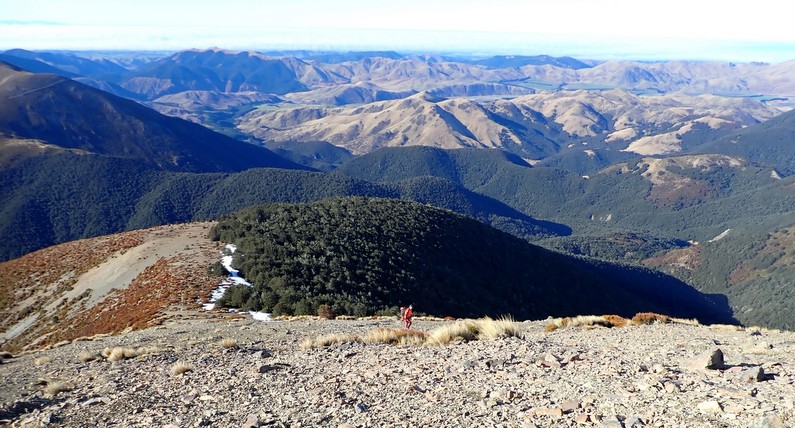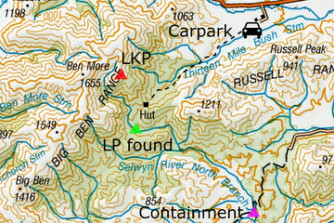
Benighted near Benmore
A successful operation for a young man lost in the Canterbury foothills highlights examples of sound incident management and search procedure, plus several lessons learned.
Early afternoon on Monday, 22nd August 2022, Police were notified that a 23-year-old man had failed to rejoin his tramping group after a side trip from Benmore Hut near Porters Pass in Canterbury.
The group had walked into Benmore Hut on the Saturday for a weekend trip. On the Sunday, they left most of their gear in the hut, and climbed to the tops near spot height .1444 for the view. After reaching the high point, clouds began to impede visibility, so they began to head back to the hut with the intention of returning home that day. As they descended the spur, the young man went ahead of the rest of the group, but wasn't at the hut when his friends arrived. His friends attempted to find him, backtracking up the ridge and searching the vicinity of the hut. They decided to stay an extra night at the hut in case their friend returned. They shouted his name and lit the hut fire in the hope that it would help him locate the hut. Finally, on Monday, they walked out to their car, and raised the alarm when they got into phone reception.
Because the person had been missing for more than 24 hours, the initial search urgency was high, and planning immediately began to get hasty search teams deployed. “We got the call from Police comms in the early afternoon, so we thought we had daylight on our side to deploy a search dog and an Oxford LandSAR team,” says Senior Constable Dennis Arthur, who was incident controller for most of the operation. However, low cloud ruled out a helicopter for initial search or team deployment, and the nearest available search dog team was in Rakaia, an hour's drive from the forward SAR Base. “That was our first lesson: everything takes longer than you think. In hindsight we needed to anticipate more and contingency plan for the likely delays.”
Initial taskings were to clear the track from the car park to the hut, and to the last known point, the .1444 spot height. The dog team was deployed ahead, with following teams using sound and light lines. Considering the possibility that the missing party had walked out via the wrong valley, another team was tasked to provide containment.

They covered the likely exit routes from Selwyn River North Branch, using 4WD vehicles on the farm tracks of High Peak Station. But by the time the teams were assembled, briefed and deployed, it was getting dark. Although the incident management team knew that the lost person had been missing for over 24 hours, they had to balance the search urgency against the conditions, reduced night search effectiveness and searcher safety. “It was late when they reached Benmore Hut. Murray Bowden [the LandSAR dog handler], got in touch to check whether we wanted them to continue that night,” says Dennis. It was challenging for some searchers who very keen to keep going, but after careful thought, the IMT decided to have them get some rest at the hut, so they could continue early and fresh the next morning. “We had concluded that this was likely to be a longer search and had shifted our planning focus that way. Murray was clearly thinking of the same considerations: it was a great example of trust, open communication and having safety at the front of our minds.”
Meanwhile, additional SAR assets were activated for an early Tuesday start. These included Amateur Radio Emergency Communcations, LandSAR teams from Christchurch, Methven and Rakaia, a CanyonSAR team and GCH Aviation. Fog delayed the helicopter’s departure, but the remainder of the mid-winters' day had perfect conditions, clear and calm. From the last known point and the intentions of the lost person, the search area was broken into segments, with each given weightings for likelihood of success. The areas were prioritised and appropriate teams matched with clear taskings. “We had contacted Alpine Cliff Rescue about searching the steep terrain in the gullies, but they suggested the Canyon SAR teams, which were better suited to that environment,” says Dennis. “It was great to see the time spent networking and exercising meant people were quick to offer good advice to aid our decision making.”
In the end, the missing person was located by the helicopter pilot, during a flight to redeploy a search team. Although uninjured, after two very cold nights in the open, he was extremely relieved to have been found. “I had worked through to 2am getting organised with plans and taskings for first thing that morning, and returned by 6am as our overnight teams were hitting the tracks again” says Dennis. “By the time I’d handed over to the incoming incident controller and headed home to sleep, I was revisiting our decisions in my mind. I had just got to bed when the phone rang around 11am; the news that he’d been found took a huge weight off. I guess that’s the biggest lesson in this whole operation. All the training we do, the relationships we form and procedures we follow provide the very best chance of a successful outcome. Have faith in the system, because it works.”
Insight summaries
• Everything takes longer than you think. Anticipate and contingency plan for
likely delays.
• Trust and open communication between searchers and incident managers is
essential for a safe and effective operation.
• Match the nature of the terrain and tasking to the capability of the teams. Consider
specialist capability when appropriate: see nzsar-resources.org.nz
• Have faith in the established procedures, which are tried and tested.
